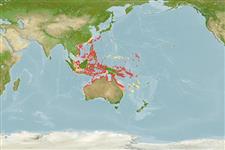Common names from other countries
Environment: milieu / climate zone / depth range / distribution range
Ecologia
marino associati a barriera corallina; distribuzione batimetrica 1 - 20 m (Ref. 90102). Tropical; 30°N - 24°S
Western Pacific: Indochina to Papua New Guinea, north to Ryukyu Islands, south to northwestern Australia and the Great Barrier Reef. Replaced by Meiacanthus kamoharai in southern Japan.
Size / Peso / Age
Maturity: Lm ? range ? - ? cm
Max length : 11.0 cm TL maschio/sesso non determinato; (Ref. 9710)
Spine dorsali (totale): 4; Raggi dorsali molli (totale): 25-28; Spine anali 2; Raggi anali molli: 14 - 16. Identified by the lined pattern on the body that ends in spots on the tail-fin base (Ref. 48636).
A solitary species found in sheltered lagoon and seaward reefs (Ref. 9710, 48636). Several adults together occasionally in close vicinity to each other (Ref. 48636). Oviparous. Eggs are demersal and adhesive (Ref. 205), and are attached to the substrate via a filamentous, adhesive pad or pedestal (Ref. 94114). Larvae are planktonic, often found in shallow, coastal waters (Ref. 94114). Several geographical variations and is mimicked by another blenny Petroscirtes breviceps (Ref. 48636). Both fang and venom gland are present (Ref. 57406).
Life cycle and mating behavior
Maturità | Riproduzione | Deposizione | Uova | Fecundity | Larve
Oviparous, distinct pairing (Ref. 205).
Myers, R.F., 1991. Micronesian reef fishes. Second Ed. Coral Graphics, Barrigada, Guam. 298 p. (Ref. 1602)
IUCN Red List Status (Ref. 130435)
CITES (Ref. 128078)
Not Evaluated
Human uses
Acquario: Commerciale
Informazioni ulteriori
BibliografiaAcquacolturaProfilo di acquacolturaVarietàGeneticaElectrophoresesEreditarietàMalattieElaborazioneMass conversion
CollaboratoriImmaginiStamps, Coins Misc.SuoniCiguateraVelocitàModalità di nuotoArea branchialeOtolithsCervelliVista
Strumenti
Special reports
Download XML
Fonti Internet
Estimates based on models
Preferred temperature (Ref.
115969): 26.4 - 29.3, mean 28.7 (based on 1647 cells).
Phylogenetic diversity index (Ref.
82804): PD
50 = 0.5000 [Uniqueness, from 0.5 = low to 2.0 = high].
Bayesian length-weight: a=0.00562 (0.00258 - 0.01228), b=3.06 (2.87 - 3.25), in cm Total Length, based on LWR estimates for this (Sub)family-body shape (Ref.
93245).
Trophic level (Ref.
69278): 3.4 ±0.5 se; based on size and trophs of closest relatives
Resilienza (Ref.
120179): Alto, tempo minimo di raddoppiamento della popolazione meno di 15 mesi (Preliminary K or Fecundity.).
Fishing Vulnerability (Ref.
59153): Low vulnerability (10 of 100).
